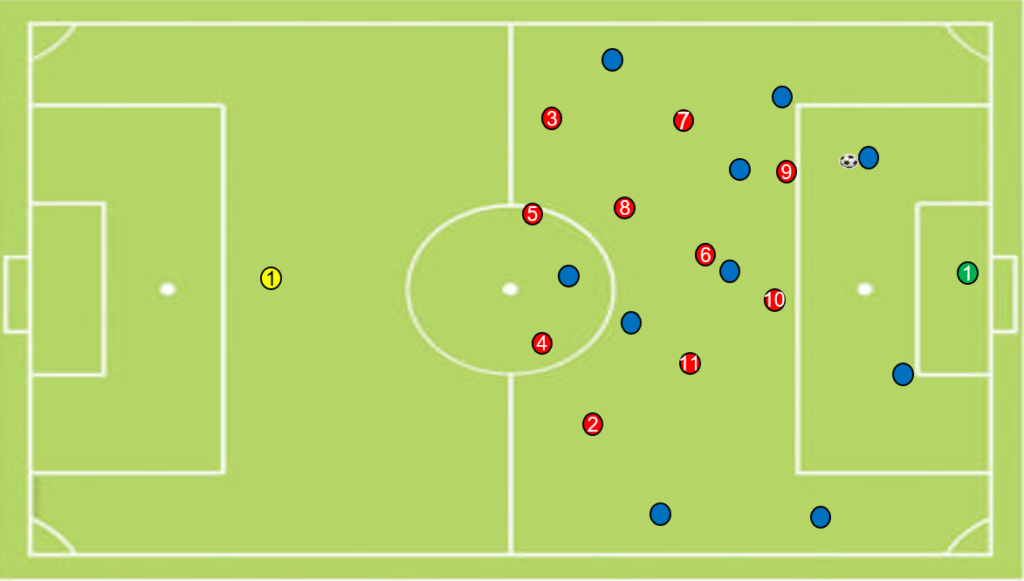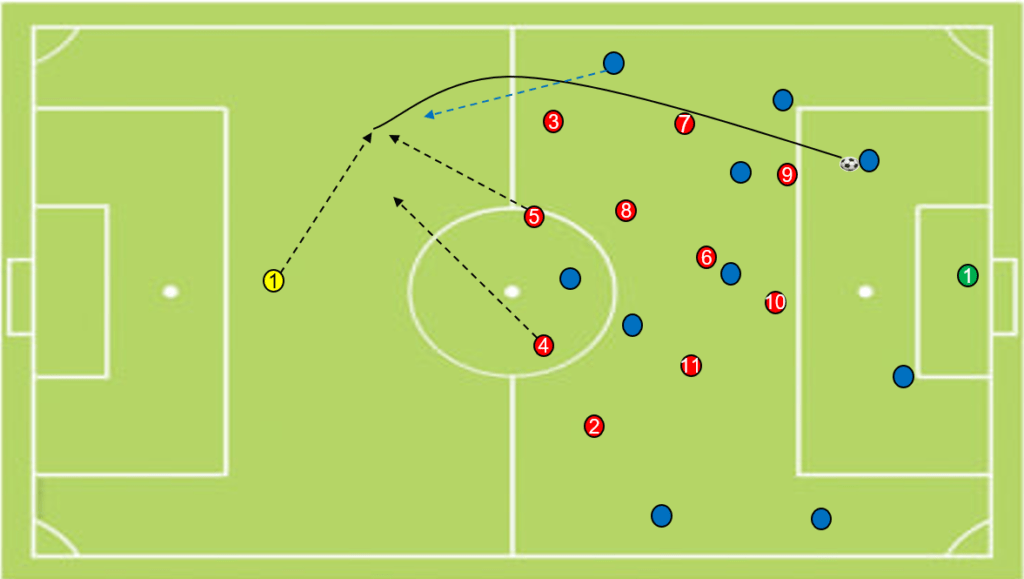The defensive organization is inevitably interlinked with the attacking attitude of the coach’s approach. The zonal marking has some basic principles but the way it will be implemented it’s up to the coach. The more attacking-minded is the coach, the more pressing behavior will be used. There are 3 types of defensive blocks, Low, Medium, and High. They are differentiated between them depending on the area of the pitch a team wishes to set up their defensive block.
Valeriy Lobanovskyi, one of the greatest coaches in football history, very often spoke about the variations of the 3 types of pressing. His ideas about football were around the pressing and how his team can transform a defending tool into an attacking one. Lobanovskyi would often use all 3 types of pressing as a tactical approach to attack without the ball. A similar approach in our days has Jurgen Klopp.
“If you win the ball back high up the pitch and you are close to the goal, it is only one pass away a really good opportunity most of the time, no playmaker in the world can be as good as a good counter-pressing situation.”
Jurgen Klopp
The great Arrigo Sacchi was a pioneer in zonal defending. His powerful Milan was a state of the art in zonal defending. He believed that in any situation the players should position themselves based on 4 reference points.
“Our players had four reference points: the ball, the space, the opponent and his own teammates. Every movement had to happen in relation to these reference points. Each play had to decide which of these reference points should determine his movements”
Arrigo Sacchi

Elevate Your Coaching Journey
Are you ready to take your coaching career to the next level? Look no further than FootballCoach365, your ultimate destination for top-notch coaching material.
Join the Coach’s Corner today and experience the transformative power of proper planning, training and coaching.
The best ever use of a Low Block zonal marking
There are no tools to regain the ball, but tolls to control the opponent’s use of possession and the area where they are allowed to enter. Mourinho has based his success on controlling the games without the ball. None can forget the 2nd leg of the semi-finals in 2010 with Inter Milan against Barcelona. His team (Inter) manage to lose only 1 – 0 and progress to the final of the Champions League by having less than 20% of ball possession.
Barcelona in that game had 20 shots but only 4 of them were on target. Inter managed to forbid the entrance of Barcelona’s players in vital areas where the XG ratio is more and the chances of a goal would be greater. They managed to control the game without the ball.
In an ideal scenario, the High Block is used against teams who prefer to build up their game from the back. On the contrary, the Low Block is used when the desired attacking approach of a coach is the counterattack, so his team needs space behind the back of the opponents. He leaves the opponents intentionally to progress high up the pitch, with the aim of recovering the ball and completing a fast attack with a forward pass in space.
Also, the 3 types of Zonal Marking blocks differ in how the players on an individual level but also collectively mark their opponents’ The closer the ball is to their own goal, the tighter the mark is. The spaces between the lines and the players should be closed so as to not allow the opponents to occupy vital areas.
Compactness
The key concept in all 3 types of Zonal Marking pressing is for the whole team to act as one. If the defensive line sits deep but the rest of the team pushes high, then there will be huge gaps between the lines that a high-quality team can take advantage of. The compactness of the defensive block is one of the top priorities regardless of the type of pressing.

The High Block
If a team wishes to use a high block, it is mandatory that the goalkeeper has characteristics of the sweeper. A sweeper goalkeeper and a central defender with the speed and the intelligence to cover up the space in cases of long balls behind the defensive line back are essential.


When a high block is used, the tactical requirement to have a +1 defender in the back line is mandatory. For example, against teams who have 1 center forward a high block is feasible because either in a back 4 or back 3 there will be a numerical superiority at the back. This will give the freedom of the spare defender to run back in case of a long ball or push forward to reduce the space in case of a pass between the lines.
The difficulties appear when the opponent plays with two forwards. In that case, the team has 3 options. The 1st option is to change their formation to a back 3. The 2nd option is to keep a midfielder in a deep position to help with the mark of the two forwards. The 3rd option is to change the type of pressing and go with a medium or low block.
The big challenge comes when the team does not have fast defenders or a sweeper goalkeeper. In that case, the use of a high block has lots of risks. Any quality long ball behind the defender’s back will leave the team exposed.
High block fundamental characteristics:
- Fast defenders
- Sweeper goalkeeper
- Players at the back line with excellent positioning, awareness, and ability to read the game
- Excellent defenders 1 v 1 situations
The mastermind in high pressing in the last decade is Jurgen Klopp. He has based his whole philosophy on high pressing, ball recoveries high up the pitch, and scoring goals with minimum passes and efforts. Check the drill Possession Game – High Pressing football like Klopp and Liverpool to get an idea of how to train your team to press high with 3 forwards or with a 4 – 4 – 2 diamond shape.
For all the coaches who wish to train and play like Jurgen Klopp, the first thing they have to do is to understand his personality, his way of thinking, and how he sees football. Any coach who wants to use an intensive high pressing way of play should read “Jurgen Klopp” biography.

“It is the intensity of the football, of how the people live football in Liverpool, all the Liverpool fans around the world. It is not a normal club, it is a special club.”
Jürgen Klopp
The Medium Block
The 2nd option of zonal marking in a block is the medium one. The compact block will be positioned in the middle of the pitch. This is the more difficult zonal defending block to implement due to the spaces left behind but also to the spaces the team will leave to the opponents to progress without pressure.
In modern football, the specific type of pressing seems to be left out. The teams prefer to defend either in a high block or a low block. In the case of a medium block, the level of tactical and positional understanding of the players should on the highest level.
There are a lot of risks when implementing a medium Zonal Marking block. There is space in front and behind the block. Against high technically quality teams, implementing a medium block will probably minimize the chances to win and increase the chances to concede goals.

How to properly use the Medium block
The medium block Zonal Marking is used only as a temporary solution when a team will move from a high block to a low one when the opponents will break the high pressure. At that point, the team will try to drop back to a low block. But, in order to avoid chaotic backward movements, the players can be positioned temporarily in a medium block.
Medium block fundamental characteristics:
- Fast central defenders
- Sweeper goalkeeper
- Players at the back line with excellent positioning, awareness, and ability to read the game
- Forwards are very good in 1 v 1 defensive situations so as to not allow the opponents to progress forward
- Very good Full backs in heading as to defend long diagonals balls to the flanks and avoid the switch of play
The Low Block
The third and final option of a zonal marking is to defend in a Low Block. To better understand what a low block is you should watch Diego Simeone and Athletico Madrid. Simeone has transformed the way to defend in a low bloc into art. Check the article How to defend in a Low Block – The “Diego Simeone Way” to get an idea of how a team can defend in a Low Block.
Defending in a Low Block can have some serious benefits. It gives to a team lots of space to counterattack, Usually, when a team defends to a Low Block, it allows the opponents to push almost the whole team to their own half. In the case of ball recovery, the team who defends in a low block has 50 meters of empty space to attack.
Against a very quality team, defending in a Zonal Marking low block is usually the most suitable solution. The distances between the players in width and depth should be very small. The players should deny any free spaces to the opponents, especially in central areas.

Low block fundamental characteristics:
- Fast attackers who can run in space in case of counterattacks
- Very good Full backs in 1 v 1 defensive situations because the opponents will most probably attack from the flanks
- Very good central defenders and a goalkeeper who can deal with crossing
Conclusion for Zonal Marking and the blocks
It is important to understand the different types of zonal marking in blocks. Each one has its pros and cons. the coach will have to decide what type of block to use based on his game model but also based on his player’s individual characteristics.
The best approach will be decided based on the amount of space the team is willing to give to the opponents and how fast they can cover it in case the opponents will break the block.
In all cases, based on recent analysis, the distance between the further forward and the last defender should be between 18m and 25m. The top teams in the world who have very fit players can defend in a Zonal Marking block between 18m – 20m. Athletico Madrid presents blocks with 15m depth but this is an exceptional case.
The zonal marking is the way to reduce the opponent’s options and lead them to spaces where the team will pressure with intense. The defensive block can be used as a way to set pressure traps, especially in wide areas.
To defend in a Zonal Marking block should not be a defensive approach but rather an interim situation between two attacks. The defensive phase is the time when the team will prepare for the next attack in order to get the opponents by surprise and disorganized.


Master class🙌🏿
Really appreciate your comment!!